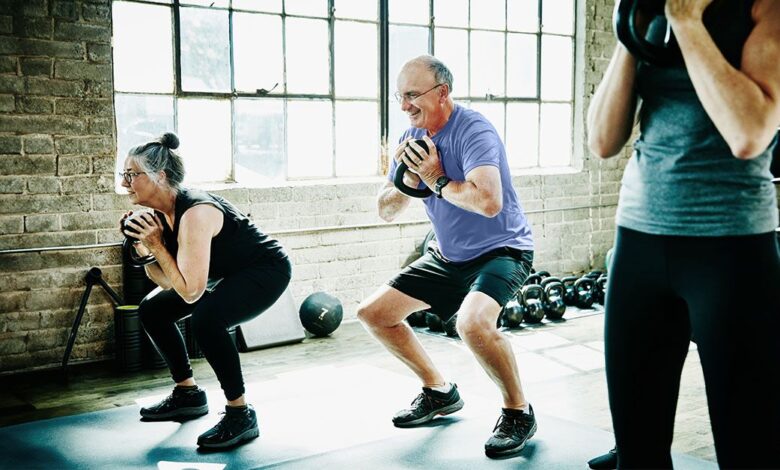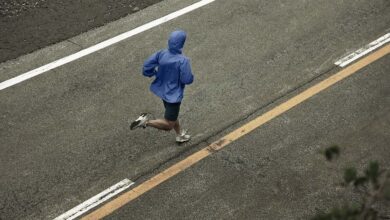How exercise can help reduce age-related fat buildup

- Certain changes occur in the body with age.
- Researchers are seeking to understand changes that happen with aging, what they mean, and what people can do to modify these changes.
- A recent study showed that tissue in older mice and humans has a buildup of a specific lipid called bis(monoacylglycero)phosphate (BMP).
- The researchers found that exercise can help decrease this buildup of fat in humans.
Some changes in the body are inevitable as people get older. However, researchers are still trying to fully understand all the changes that happen and what they mean for the health of aging adults.
A
The researchers first identified the lipid using mouse tissues and then found similar results in human muscles. They then found that levels of this lipid could be reduced via exercise among postmenopausal women.
The results point to another possible benefit of exercise and the need for more research regarding this lipid buildup.
The researchers of the current study note that studying complex lipids (fats) may help with understanding age-related disease and overall longevity.
For that, they first examined ten different tissues in young and old mice to understand age-related differences in lipids. They found that more lipids began accumulating with age in most of the tissues they examined. The primary lipids they found were called Bis(monoacylglycero)phosphates (BMPs).
Next, researchers wanted to see if a similar BMP accumulation occurred in humans. They collected muscle biopsies from younger men and women between twenty and thirty years old and older men and women between sixty-five and eighty. While there were differences between the muscle tissue samples of men and women, researchers did find a buildup of BMPs in older participants.
Study authors Georges E. Janssens, Frederic M. Vaz, and Riekelt H. Houkooper noted to Medical News Today the following possible significance of the buildup of BMP with age:
“BMPs — the lipid we found to accumulate with age — have previously emerged in literature as markers of disease or stress. BMPs accumulate in various diseases, including chronic kidney disease, diseases related to cholesteral accumulation and vascular diseases, and certain genetic metabolic disorders. It may turn out that BMP levels will serve as a reference marker for healthy aging but more work is required for this.”
Next, researchers wanted to see if exercise could influence BMP levels. For this portion of the study, researchers included 12 postmenopausal women between the ages of 45 and 70. These women were overweight and were doing less than three hours of exercise each week.
They conducted a randomized, cross-over intervention utilizing three different activity regimens: a sitting regimen, which involved sitting for fourteen hours a day, an exercising regimen, which involved exercising for one hour each day, and a standing regimen, which involved standing for three hours each day and walking for two hours each day. The participants did each regimen for four days and had a muscle biopsy taken on the fifth day.
The researchers found that even over the short intervention period, levels of BMP were lower following exercise intervention.
The study authors further noted the following highlights of the research:
“While it’s known how simple lipids (e.g. cholesterol) contribute to aging and disease (e.g. atherosclerosis), little is known on how ‘complex’ lipids (with 3+ chemical moieties with polar properties, e.g. phospholipids) contribute. We set out to explore the relationship between complex lipids and aging… There was a nearly tissue-wide accumulation of one lipid, bis(monoacylglycero)phosphate (BMP) in mice, and the same change was conserved in human muscle (in both men and women), which was astonishing. Taking this further, performing a short-term exercise intervention in postmenopausal women revealed that levels of this lipid could be reduced following exercise.”
This research does have a number of limitations. First, the initial research utilized mice, which is not always applicable to humans. However, further analysis of human muscle tissue seems to confirm similar findings. The researchers note that they also only used male mice, and there are differences in lipid metabolism between male and female mice.
They only used a small number of people for their biopsy collection and only looked at one tissue type, so future research could include even more information in this area. The exercise intervention only included women, so future research, including mixed groups, could also be helpful.
The exercise interventions also only lasted a short time, so it could not look at the long-term effects of exercise on BMP levels. The researchers also acknowledge that all lipids may increase some in the body with age, but they suspect that BMP increases much more than other lipids.
Finally, researchers had limited data on the use of lipid-lowering medication, so future research could see how the use of these medications influences BMP levels.
The researchers further note that more research is required to understand the increase of BMPs with age and whether this is helpful or harmful to the body. The study authors also shared with MNT the following insights into future research in this area:
“The next steps are to better understand why the accumulation of BMP occurs in the first place (is it due to more production of BMP, or that BMP can not be broken down?), and then to better understand if it is a detrimental change happening with age (causing disease) or a beneficial one (a protective response the body elicits, in response to other damage occurring with age).”
The results of this study point to another potential reason for older adults to exercise regularly if possible. Paunel Vukasinov, MD, board certified internist with Medical Offices of Manhattan, who was not involved in the study, noted that it was still too early to make assumptions about the long-term effects of these lipids.
“The study brings forth an interesting finding regarding accumulation of certain lipids that occurs with aging and how this accumulation impacts the aging process . It is still early to determine the long term impact of these lipids, and further study is necessary. This study further underscores the importance of encouraging regular physical activity, especially as we age. Regular exercise maintains strong muscle which preserves mobility, improves cognitive function and sleep, and even has a positive impact on energy and mood.”
— Paunel Vukasinov, MD
While further research is still required, older adults can also consider the many other benefits of regular exercise. For example, the World Health Organization (WHO) notes that
Older adults can seek proper guidance to develop individual exercise plans that allow them to stay safe while maximizing their independence and well-being. As noted by the Centers for Disease Control and Prevention (CDC),
Get Best News and Web Services here







